OneHistory Discussion Questions for Images
(For Teachers)
These questions can be used to prime a discussion of most photographs. Not all images will provide the same kind of information or provoke the same kind of discussion. But if you approach the photograph as a mystery to be solved, you'll be surprised at how thoroughly your students will become engaged.
 What does the photograph as a document tell you?
What does the photograph as a document tell you?
Start with the very basics. What do you see in the photograph? What can you tell about the people? Are they rich? Are they poor? Do you think the photograph was taken recently? Why?
You may have to provide some of this information to your students. Some may not know, for example, that color photographs are usually more recent than black and white photographs. There may be objects in the photograph that you can identify but your students can't.
 Is there a caption or any written material on the back of the image? What information does it give you?
Is there a caption or any written material on the back of the image? What information does it give you?
Read the caption with students and clairfy any terms they may not understand. Then look back at the image and ask whether the caption changes or adds to the information they got from the photograph at first.
 What kind of photograph is it?
What kind of photograph is it?
Studio? Documentary? Snapshot? Advertisement? To give students a sense of photographic genres, you may want to show them the photographs that illustrate "How to look at a photograph."
 What is the historical context of the photograph?
What is the historical context of the photograph?
Again, you will probably have to provide the context for students. Then discuss with them how the context helps them interpret the photograph.
 Why was the photograph taken?
Why was the photograph taken?
The reasons photographs were taken often parallel "Author's Purpose" in reading literature. Was the photograph taken to inform, to entertain, to persuade, to express a feeling or insight?
 What is the bias of the photographer?
What is the bias of the photographer?
This will relate to both of the two previous questions. The photographer may have a bias that arises from the time and place in which he or she lived. And the purpose of the photograph may add to that bias.
 What is your (our) bias?
What is your (our) bias?
This is as important a question as the previous one. Our expectations are very different from those of people living a century ago. Comparing their own viewpoint with that a earlier time by discussing a photograph can give students great insight into their own assumptions and prejudices.

